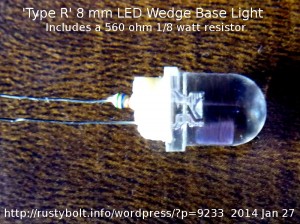 I took apart a “Type R” LED light, which is a substitute for a wedge base auto light used in instrument panels and dome lights. This light has an 8 mm diameter LED and a 560 ohm, 1/8 watt resistor in the wedge base. Assuming that the LED drops 3.2 volts and the auto’s battery voltage is 13.8V, the resistor has 10.6 volts across it, and that calculates to slightly less than 20 milliamps current. That’s fine for the LED, but if it’s rated for more than a tenth of a watt, then it could handle more current. But the resistor isn’t so fortunate.
I took apart a “Type R” LED light, which is a substitute for a wedge base auto light used in instrument panels and dome lights. This light has an 8 mm diameter LED and a 560 ohm, 1/8 watt resistor in the wedge base. Assuming that the LED drops 3.2 volts and the auto’s battery voltage is 13.8V, the resistor has 10.6 volts across it, and that calculates to slightly less than 20 milliamps current. That’s fine for the LED, but if it’s rated for more than a tenth of a watt, then it could handle more current. But the resistor isn’t so fortunate.
The formula for the dissipation of a resistance is voltage squared divided by the resistance. In this case, we have 10.6 squared divided by 560, which gives a bit more than 200 milliwatts. This is a 1/8 watt resistor, or 125 milliwatts, so the resistor is dissipating 60 percent or more than its maximum rated wattage. This little resistor must be getting very hot. And that is an invitation to catch fire, or short out, or both, in which case the LED will be subjected to too much current and also overheat and most likely fail. And the excess heat could shorten the life or damage the LED.
And this assumes the battery voltage stays at 13.8 volts. Problem is that the voltage during charging may go quite a bit higher, up to 15 volts. So there are even worse conditions that the light may encounter. Another factor is the fixture that it’s in may get warm from other things such as electronics or even other lights. If you ask me, this does not seem to be a safe light to use in an a vehicle.